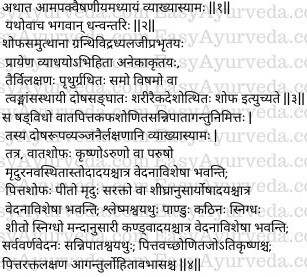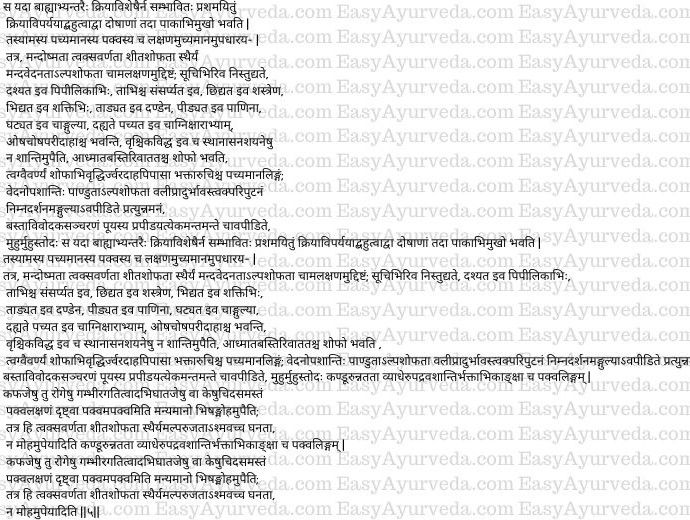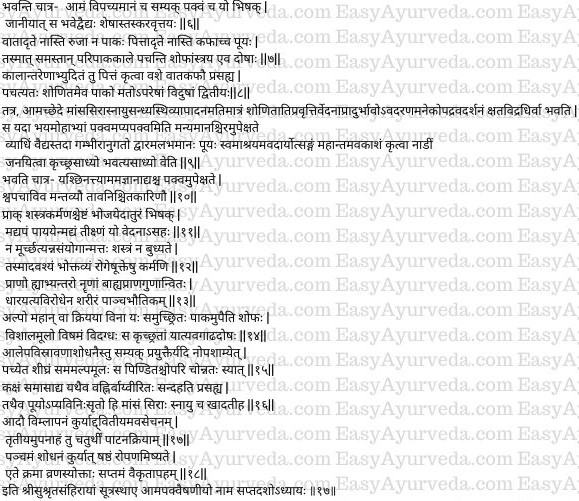Amapakvaishaniya Adhyaya-Knowledge of unripe and ripe swelling
We will now expound the chapter by name Amapakvaishaniya – Knowledge of unripe and ripe (swellings) as revealed by the venerable Dhanvantari.
Shopha nirukti
Definition of Shopha
Granthi (cyst / tumor), Vidradhi (abscess), Alaji (a kind of skin disease) and such other diseases which manifest with different shapes generally arise with Shopha (swelling – odema). This means to tell that these diseases are associated with swelling (the main presentation of these diseases is swelling).
Apart from these swellings, there is another kind of swelling which has spread out (isolated), knotted (cystic), even or uneven, occurring in skin and muscle etc tissues, which occurs in the form of accumulation of doshas in any one place of the body. Such swelling is called as Shopha.
Shopha Bheda
Kinds of inflammatory oedema
Shopha is of six kinds viz, one each by Vata, Pitta, Kapha, Rakta, Sannipata (all these three Doshas together) and Agantu (due to external causes).
We will describe these six kinds of shopha in accordance with the Dosha features and symptoms as follows: –
- Vata Shopha: – The swelling produced by aggravated vata is either light red (crimson) or black in color, rough or soft, unsteady, and will have pricking pain etc are its specific symptoms (which will sometimes increase and sometimes decrease).
- Pitta Shopha: – The swelling produced by aggravated Pitta is yellow, soft, slightly red, quickly progressing, feeling of burning sensation etc, are its specific symptoms.
- Slesma Shopha (kapha Shopha): – The swelling produced by aggravated Kapha is pale (yellowish white) or white in color, hard, cold, unctuous, slowly progressing, itching etc. are its specific symptoms.
- Sannipata svayathu – The swelling produced by aggravation of all the three doshas together has all kinds of colors and pains.
- Shonitaja (Raktaja) Shopha – The swelling produced by aggravated blood is similar to the swelling produced by pitta (and will have similar signs and symptoms as those of pittaja shopha), and is very black in color.
- Agantuja Shopha – The swelling produced by external causes like blow, injury, insect bites, foreign bodies, poison etc will have symptoms similar to those of Pitta and Rakta kinds of edema and will illuminate (appear as having) red color-are its symptoms.
Read – Types Of Swelling – Ayurveda Diagnosis Charak Samhita Sutrasthan-18
Ama-Pakva Lakshana
Signs of unripe and ripe swelling
Due to opposite or improper treatments being done or due to severe aggravation (and accumulation) of the doshas, if the swelling does not subside either by different kinds of external or internal treatments, then it should be considered that the swelling is going in for paka (ripening / pus) formation.
Now listen to the symptoms of its unripe, ripening and ripe stages, as described by me (as follows): –
- Ama Shopha Symptoms – mild (increase of) temperature, color (around the swelling) same as that of the surrounding skin, swelling being cold to touch, static (immovable), mild pain, and slight swelling are the symptoms in Ama (unripe) stage.
- Pachyamana Shopha Symptoms – pain like being pricked by needles, a sense / pain of being bitten by the ants or ants crawling all over the body, as though being cut by sharp weapons, split / punctured by pointed weapons, beaten by batons, hit by the hand, squeezed by the fingers, as being burnt by fire and Alkalies, burning sensation locally and generally all over the body; the person does not find comfort in sitting, lying or sleeping as though being stung by scorpion; the swelling resembles like a bag distended by air (on palpation – as felt on touch by the physician), change of color of the skin, increase in the size of the swelling, fever, burning sensation, thirst, loss of appetite – these are the symptoms of Pacyamama (ripening) stage of swelling.
- Pakva Shopha Symptoms – Subsiding of pain, color of the body getting pale or white, decrease of swelling, appearance of wrinkles and cracking of the skin, appearance of depression (pitting) when pressed by the finger and quick elevation once the pressure has been released, movement of pus as found in a bag of water i.e. the pus moves in the swelling just like the water moves in a bag from place to place (fluctuation) – this fluctuation is experienced at one end of the swelling when the swelling is tapped or pressed with finger of the other hand on the other side of the swelling, pricking pain occurring again and again, itching, subsiding of the elevation of swelling, subsiding of complications (secondary diseases) and desire for food etc, are the features of Pakva (ripe) swelling.
In disease (swelling) produced by Kapha because of deep rootedness of the swelling or in those produced by injury, when the physician does not find complete signs of ripening of swelling, he might mistake the ripe stages as unripe stage and become confused. But by (seeing) the color of the swelling being similar to that of the surrounding skin, swelling being cold to touch and stout (large), presence of mild pain and hardness like stone, the physician should not become confused (since these are the symptoms of unripe stage itself).
The real physician should know the stages of swelling
He who recognizes the unripe, ripening and ripe stages of the swelling clearly, can only be called the (real) physician, whereas all others are swindlers.
Read – Charaka – Shotha Chikitsa 12th Chapter
Dosha Sambandha
Without the involvement of vata there is no pain. Without the involvement of pitta there is no suppuration (ripening). And without the involvement of Kapha there is no pus. Hence during the stage of ripening of the oedema (inflammatory) all the Doshas are involved (in ripening the oedema / swelling).
Pitta becoming greatly aggravated in course of time subjugates vata and kapha by force and causes ripening of Sonita (blood) only; this is the second opinion of some other scholars (about the ripening).
Chedana Kala
Proper time for incising
If cutting is done in the unripe stage, there will be
- great destruction of muscles, veins, ligaments, joints and bone,
- too much of bleeding,
- development of pain,
- tearing, and
- appearance of many complications (secondary diseases) or
- development of a traumatic abscess
When the physician either by fear or ignorance decides the disease (swelling) as unripe though it is ripe and neglects it for long time, then the pus remaining deep inside, not getting an opening, creates a big tear above in its own place, leading to formation of a big and deep sinus, then it becomes either curable with difficulty or even incurable.
He who cuts the unripe due to ignorance and he who ignores the ripe one (without cutting) both (types of physicians) are to be considered as equaling to pariah (outcast) who follows and performs uncertain actions.
Sanskrit Versus



Purvopachara
Preoperative regimen
Before undertaking the surgery, the physician should make the patient consume good food i.e., the food which the patient desires and is also compatible with him or her. The physician should make the patient drink strong wine to a patient who is unable to tolerate the pain of the surgical process and is habituated to drinking wine.
In the presence of food, the patient does not faint. Similarly, he does not experience the pain (of the knife – used during surgery) when intoxicated with strong wine. Hence the patient should be given food necessarily, before doing surgical activities in diseases wherein giving the food to the patient has been mentioned.
Internal Prana (life) getting support from the external Prana (food) maintains the body composed of the five primary elements without opposition.
Suppuration of swelling and prognosis
The swelling which is either small or big if left untreated will grow up and undergo ripening. Such a swelling gets deep rooted, spreads irregularly and widely and improperly cooked (immature). The doshas in such swelling would get deep (gets seated in deeper tissues) and become difficult to cure.
What type of swelling would ripen quickly?
If the swelling does not subside even after application of medical pastes, draining, and cleaning, all properly done, still found to be even, and not deep rooted, bulges up like a round mass and will ripen quickly.
Just as a spark of fire inside hay getting augmented by the wind burns up a heap of grass (and everything else) quickly, similarly the pus, if not drained out of the swelling (or anywhere in the body), destroys the muscles, veins and ligaments.
Read – Sushruta’s 8 Types Of Surgical Procedures – Astavidha Shastra Karma
Shopha Upakrama
Treatment of swelling
Firstly Vimlapanaa (softening by kneading with fingers) should be done, the second treatment is Avasecana (bloodletting), the third one is Upanaha (warm poultices) and the fourth one is Patana (cutting / incising). The fifth treatment is Sodhana (cleaning), the sixth one is Ropana (healing) and seventh one is Vaikrtapaha (removing, warding off the abnormalities). These are the seven successive treatments for Vranashopha i.e., ulcer associated with swelling.
Thus ends the Seventeenth chapter named Amapakvaishaniya in Sutrasthana of Sushruta Samhita.




